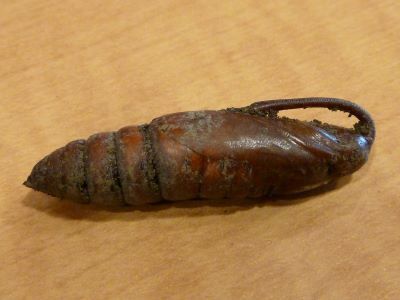
Good Natured: Hornworms
Fall is in full swing these days, with animals everywhere getting ready for the winter that lies ahead. Birds are migrating; mammals are storing fat and/or food—I personally can vouch for that one. And the hornworms have put themselves to bed until spring.
I know this because there's one napping on my desk. Or at least there was, until I tucked it back in again, in the soil on the south side of my house.
The hornworm pupa arrived a few weeks ago, special delivery from a gardener friend who'd dug it up while harvesting potatoes. Being one of those natural items that folks just aren't sure about, the brown and, when warmed, wriggly, creature was set aside and then dropped off at Casa Otto for identification.
I recognized what it was by its size, and the prominent proboscis sheath extending from the head. But, moving on to the bigger question, what the heck is a hornworm?
“Hornworm" is the common name given to many species of caterpillars in the Sphingidae, or sphinx moth family. The name refers the prominent spike, or “horn," that rises from the rear of many of these larvae.
Their other common name, sphinx moth, also can be traced to the caterpillars and their tendency to rear their heads back, sphinx like, when threatened. Over 100 species of sphinx moth call North America home. But today we're going to focus on only a couple: tobacco and tomato hornworms. Yep, those big, green caterpillars that like to hang out in gardens, munching on tomato plant and, sometimes, pepper, eggplant and potato plants.
I'm not a caterpillar expert, but I'm pretty sure the hornworm pupa I inherited is one of these two species. And, if I had to venture a guess, I'd go with tobacco hornworm, Manduca sexta. Also known as the Carolina sphinx moth, this is the species more common in our area. The tomato hornworm, Manduca quinquemaculata, which matures into the five-spotted hawkmoth, just isn't seen as often in Kane County, even though we have way more tomato plants than tobacco plants growing here.
Regardless of which one we have, it's a given that it spent the last few days of its caterpillar-hood munching and crunching away on garden greenery. As these larvae grow and molt, their appetites increase right along with them. In fact, entomologists estimate that 90% of the plant material hornworms consume is gobbled up in their final instar, or developmental stage—the days leading up to pupation.
It's that seemingly destructive behavior that's given these fascinating creatures a black eye (or black ocellus, if you're into technical terms). But, I'll go out on a limb here and say that, while it's easy to accuse the caterpillars of bad behavior, we're really the ones to blame.
Tobacco and tomato hornworms are just like the raccoons, skunks, opossums, chipmunks, geese (choose the “nuisance" species of your choice) that are all around. They thrive here in suburbia because of the ideal conditions we've created.
By nature, tomato and tobacco hornworms feed on plants in the Solanaceae, or nightshade, family. While there have always been some native representatives of this group here in northern Illinois, the numbers grew exponentially as more folks settled here and more gardens were planted.
So here we are today, living amid a landscape loaded with food for tobacco and tomato hornworms. When you think about it that way, it's no wonder these caterpillars and, now, pupae, are showing up in gardens, mulch and compost piles.
I probably should add that while hornworms are among our largest and most common moth pupae found in soil, they're by no means the only ones. Another jumbo species that turns up with some regularity is Eacles imperialis, the imperial moth, a member of the Saturniidae or giant silkmoth family.
Imperial moth caterpillars are stout and measure 4 in. long—the same length as tobacco and tomato hornworms. However, because E. imperialis does not feed in its adult stage, its pupae lack that big proboscis sheath the sphinx wear so well.
And use so well! The sphinx moths that develop from those tobacco and tomato hornworms visit a variety of flowering plants and unfurl those long “tongues" to sip nectar. In the process they pick up pollen and transfer it to the next plant they visit.
You read that right. The moths that develop from the caterpillars some gardeners love to hate grow into helpful pollinators. Pretty neat, huh?
If you still have some gardening chores to attend to, perhaps pulling up some spent vegetable plants, or giving the compost pile a turn, keep an eye out for hornworm pupae. If you're like me, you'll want to warm it briefly in your hands to watch its chunky abdomen squiggle in a most intriguing way, then tuck it back into the soil so it can resume its long winter's nap.
Next year, when the weather warms, the mature sphinx moth—which can hover so elegantly it sometimes mistaken for a hummingbird—will emerge to begin the cycle again.
Pam Otto is the outreach ambassador for the St. Charles Park District. She can be reached at potto@stcparks.org.

